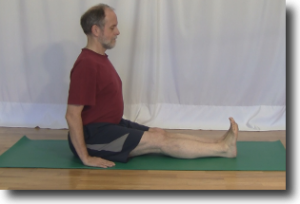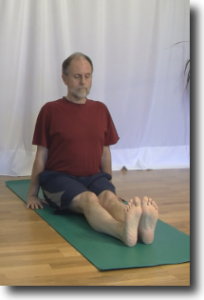The butterfly moves gracefully from flower to flower, taking a sip of nectar from each. The butterfly’s colourful wings move back and forth through a very large range of motion as it floats on the air.
Alice watches the butterfly and realizes how much her shoulders have become like the butterfly’s wings. Not nearly as colourful but they sure move a lot more than they used to.
What is Dandasana
Dandasana is one of the anchor poses in yoga. This is the seated pose that you return to after you have completed the pose you are working on.
Dandasana, pronounced dahn-DAH-sah-nah, is know as Staff pose in English. You sit on your mat with your legs together out in front of you and your torso rising vertically out of your hips. It looks like two staffs. One laying on the ground and the other rising straight up out of the ground.
Dandasana helps to improve your posture, stretches your hamstrings, strengthens your back muscles and stretches your shoulder muscles.
How to do Dandasana
You enter Dandasana by sitting on your mat with your legs out in front of you, sitting tall and resting your hands beside your feet. Of course there is a lot more to the pose than that.
Your legs are out in front of you with a slight gap between your heels, and your big toes are touching. Bring your feet to a vertical position by drawing your baby toes back towards your hips.
Bring the back of your hips up to a vertical position just like you did with your feet. This establishes the base for your torso. Lift your torso up tall, maintaining the natural curves in your spine. Draw your shoulders back and drop them down your back towards your hips while lifting your ribs.
Rest your hands lightly on the floor beside your hips and directly beneath your shoulders.
Keep your neck tall, lift your head and look to the horizon.
Hold this position for several breaths before you enter your next pose.
One of the common challenges with Dandasana is getting your shoulders in the right place and this is where the butterfly factor comes into play.
What is the Butterfly Factor
A butterfly flies gently from flower to flower by moving its wings in great sweeps. In Dandasana the challenge is to do the same thing as the butterfly and move our shoulders in a great sweep as well. The butterfly factor works on increasing flexibility in your shoulders and straightening your spine.
Lift your ribs, straighten your upper back, drop your shoulders down your back and bring your shoulder blades towards each other to implement the butterfly factor.
Why do you need the Butterfly Factor
Most of us when we enter Dandasana will discover that we have our shoulders rounded, our chest dropped down towards our hips and our shoulders are coming forward and down. Our upper back is rounded and we are slouching.
One of the common causes of this poor posture is the large amount of time we spend in front of our computers.
Dandasana in combination with the Butterfly Factor can correct the hunched posture and replace it with a tall spine and the shoulders drawn back into place.
How to implement the Butterfly Factor

Lift your ribs, draw your shoulder blades towards your spine and down towards your hips to implement the butterfly factor.
Once you are in Dandasana, lift your ribs up and away from your hips. Take the compression out of your abdomen that your dropped ribs and rounded back are causing. However you do not arch your back, rather you are looking to straighten your spine.
Now that your ribs are lifted you focus next on your shoulders.
Bring your shoulders down from your ears, draw your shoulder blades together towards your spine and move them down towards your hips.
You are doing the Butterfly Factor correctly when you feel the muscles in the front of your upper chest stretching and the muscles in your upper back contracting and your ribs are lifted. You should also notice that your shoulders are moving from being in front of your ribs back to being closer to your spine.
What are the benefits of the Butterfly Factor
The Butterfly Factor improves your posture by lifting your ribs up and straightening your upper spine.
You are removing the tension from your neck and shoulders when you move your shoulders down from your ears and then draw your shoulder blades towards your spine.
Will the Butterfly Factor help my hands reach the floor?
This movement could make the difference between your hands hovering above the floor and your hands landing gently on the floor.
But my chest and back muscles are getting sore!
This is a common problem when you first start working on getting your shoulders to come back and move down your back. It has taken a long time for you to become comfortable with your shoulder up near your ears and hunched forward. This movement up and forward developed gradually over many years. It is going to take many yoga classes and lots of repetitions of Dandasana before your muscles become comfortable in this new place and you start to view it as natural.
Summary
The butterfly moves its wings all of the time as it flies from flower to flower. All Alice is trying to do is get her butterfly wings (her shoulders) to move back once each time she does Dandasana and become comfortable in their new place.
Alice lifts her ribs, draws her shoulders down from her ears and draws her shoulder blades back towards her spine. She feels a lot taller and the compression is gone from her abdomen.
Next Step
Ask your yoga teacher to check out your posture and your shoulders the next time you are doing Dandasana. They will be able to help you to fully implement the Butterfly Factor.
Additional Reading
For another view of protecting your neck and shoulders read How to protect your neck in Paschimottanasana.
The article Why there is no Rocket factor in Dandasana helps you avoid a common problem once your hands reach the floor.
And finally How to build your Goal Post in Dandasana teaches you what to do with your arms in Dandasana.





